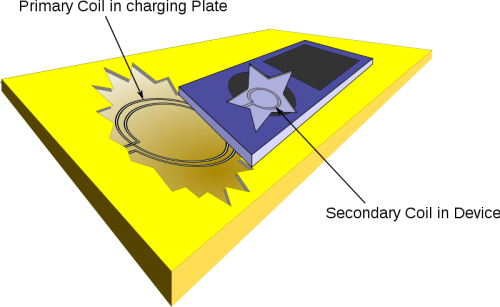Wires, cables, intestines, or anything ropey for that matter, are not simply placed in to this world to move resources from one point to another. No, they also exist to torment us and test our mental endurance when tangled. So whenever there’s a possibility to cut them out of our lives even a bit, take heed I say!
Wireless chargers are a blessing in disguise, sometimes allowing you to charge multiple devices simultaneously, thus alleviating the household congestion. This is not the work of magic, but science in the form of inductive coupling: the use of magnetic fields to transfer energy between objects.
Electric current moving through a wire will generate a circular magnetic field. When the wire is coiled, the current is enhanced and the resulting magnetic field can be extended to a second coil if placed within the magnetic field’s vicinity. Transformers use this same principle to operate, but they house both coils within the unit itself.

Image courtesy of Wikipedia.org
Why does this happen? When a conductor is exposed to an alternating magnetic field, it causes a change in current that produces a voltage across both coils. The voltage is transferred from the primary coil, acting as the charger, to the secondary coil, acting as the receiver. This how the battery of your mobile phone, or whatever device placed on the charging mat, is charged.

Image courtesy of Howstuffworks
Be aware that not all gadgets are capable of charging wirelessly. They will not respond to the magnetic field if not manufactured with the proper coils; furthermore, if the battery itself is not charging when apt to do so, there is a high probability that the fault lay in the battery itself.
Advantages of inductive charging: Since the electrical conductors are not exposed, there is less risk of electrocution or short circuiting from exposure to moisture, as in the case of the electric toothbrush. Multiple coils can be magnetized together, thereby making it possible to charge multiple wireless devices on one charging mat and eliminate handfuls of wires. More importantly, inductive coupling enables medical devices to be charged inside your body so as not to make it obvious you are a Cyborg.
The future: The magnetic fields produced through inductive coupling are very small and can only transfer voltage within a short distance. For this reason, it is not true wireless charging in the sense of completely eliminating the space between the charger and the battery. Nevertheless, research conducted at MIT by Marin Soljacic’s team has demonstrated that it is possible to transfer power up to seven feet using resonant frequency, the frequency at which objects naturally vibrate.
By attaching capacitance plates holding a charge to the ends of a coil, multiple coils can be tuned to the same resonance frequency, thus enabling a non-radiative energy transfer. Unlike magnetic fields, the energy is not radiated in all directions because it is funneled directly from coil to coil thus enabling a concentrated flow of power.
The implication of this technology in public spaces means you'll never have to carry chargers again. No more cluttered wires in bag space, simply active a button and the device will recharge its battery anywhere.
Do you have any questions or ideas pertaining to wireless technology? Visit TechXchange to share them.
Advertisement





